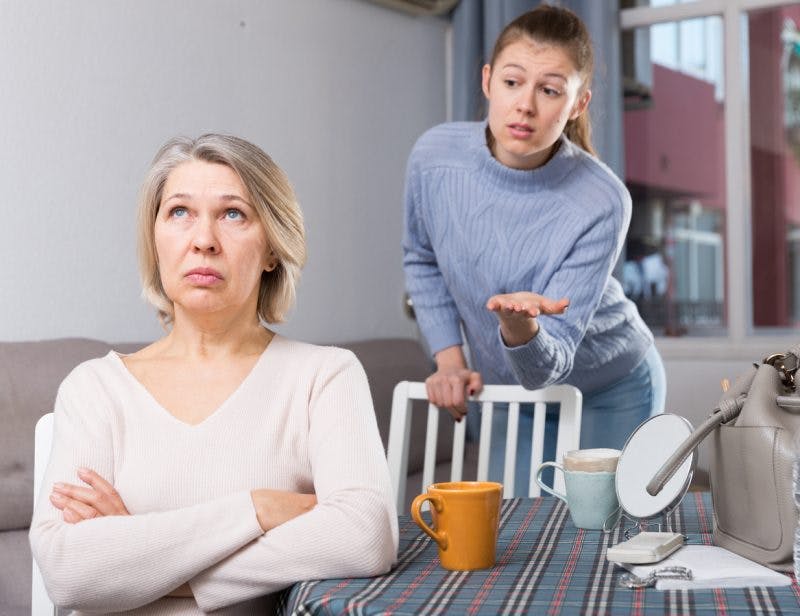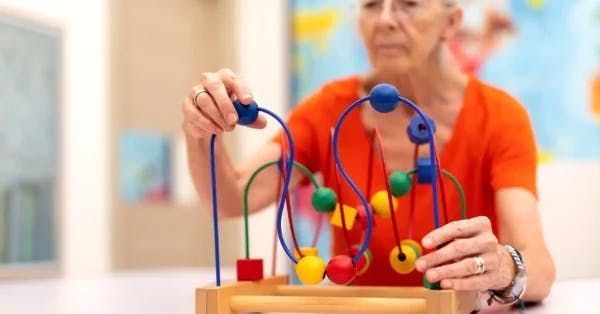Childlike behavior after stroke can be distressing for both the survivor and caregiver. Generally, changes in behavior after stroke are related to the neurological impact of stroke, as behavior is modulated by various areas of the brain. Not everyone who experiences a stroke will demonstrate childlike behavior, but personality changes are common.
When an individual demonstrates childlike behavior after stroke, they may be prone to emotional outbursts, exhibit impulsivity, and act with a lack of social inhibition. While these behaviors may appear immature, they typically are treatable and unintentional actions brought on by the aftermath of stroke. In fact, some survivors may have minimal, if any, awareness that how they are acting is inappropriate.
This article will further explain what childlike behavior after stroke may look like, how it may be caused, and how to manage it. Use the links below to jump directly to any section.
Symptoms of Childlike Behavior After Stroke
While there are no set guidelines for what childlike behavior after stroke entails, there are numerous effects of stroke that could be classified as childlike behaviors. These behaviors are often exhibited unintentionally by the survivor.
Furthermore, many survivors are unaware that their behaviors are inappropriate, a condition referred to as anosognosia. This lack of insight can make it challenging for survivors to identify and address childlike behaviors.
Common symptoms of childlike behavior after stroke include:
- Impulsivity
- Disinhibition
- Emotional lability
- Lack of empathy
- Reduced attention span
- Poor decision-making skills
- Aggressive behaviors
- Self-centeredness
While these symptoms can make interactions with survivors more challenging, it is important to remember that survivors are usually not intentionally being difficult. Although they may appear to have an entirely different personality, these changes may be purely aftereffects of stroke. With this in mind, it is often possible to address and improve childlike behaviors after stroke, allowing the survivor to act more like their pre-stroke self again.
Causes of Childlike Behavior After Stroke
The sources of childlike behavior after stroke vary widely. Behavioral changes may occur secondary to physical or psychological changes, or as a more direct result of damage to certain areas of the brain.
For example, survivors with physical effects limiting their ability to speak, walk, or care for themselves independently may, in a lot of ways, be left feeling like a child. This can potentially lead them to act more self-centeredly, especially if they need to rely on others for their personal needs.
Psychologically, a stroke is a very stressful event. Some survivors may resort to exhibiting childlike behaviors as a coping mechanism to manage the stress associated with life after stroke. These behaviors are often a cry for help or attention, especially in stroke survivors who have limited independence.
Neurological causes of childlike behavior after stroke are primarily associated with where in the brain the stroke occurred. The frontal lobe, including the prefrontal and orbitofrontal cortices, is primarily responsible for higher-level cognitive functions and personality traits. Damage to the frontal lobe, therefore, may result in personality changes and limited executive functions, which may manifest as childlike behaviors.
The frontal lobe is one of the last areas of the brain to fully develop, often not maturing until age 25. This is one of the main neurological reasons that children and teens think and act differently than adults: their frontal lobes are not fully mature.
Therefore, when an adult sustains a frontal lobe stroke, childlike behaviors may reemerge because the frontal lobe is no longer able to function in its fully mature and healthy state. Damage to other areas of the brain, such as the limbic system, may also be associated with childlike behaviors after stroke.
When survivors have experienced a series of strokes or have other factors that reduce blood flow to the brain, they may develop vascular dementia. This may also contribute to childlike behaviors, as individuals with vascular dementia may demonstrate mood swings, poor decision-making skills, reduced attention spans, and behavior changes.
Regardless of the cause of childlike behavior after stroke, there are various management strategies that may be effective. Knowing the cause of childlike behavior may help survivors and their families determine which management strategies may be most effective for their specific needs.
Managing Childlike Behavior After Stroke
No two cases of stroke are ever entirely alike due to variances in the severity and location of damage. Therefore, a treatment or management strategy that works to address childlike behavior for one person may not necessarily work for another.
However, there are some common strategies to address childlike behavior after stroke that may be effective. Survivors, with the support of family members and caregivers, should consider the strategies below to help manage and improve childlike behavior after stroke.
Psychotherapy
Pursuing psychotherapy, sometimes referred to as talk therapy, can help survivors learn to manage their emotions and behaviors following stroke. Psychotherapists are professionally trained to help identify what triggers certain behaviors, and may help survivors find ways to eliminate or reduce exposure to triggering situations.
Psychotherapists may also recommend specific coping strategies to help with emotional and behavioral regulation. This can be especially effective for individuals exhibiting childlike behaviors related to difficulties adjusting to life after stroke.
Listening to Others
Childlike behavior can include self-centeredness and a lack of empathy for others. This can cause survivors to act insensitively, which can upset those surrounding them.
When survivors are aware that they are displaying childlike behaviors, making an effort to really listen to loved ones and take constructive criticism can help them to improve. However, this strategy may be ineffective and frustrating for survivors lacking insight, as they may not understand that their behaviors are inappropriate.
Meditation
Meditation can be a very effective coping mechanism for stroke survivors. Taking time to fully focus and reflect on one’s emotions and thoughts will promote mindfulness and self-acceptance. Practicing both meditation and mindfulness can help survivors regulate their emotions, leading to more positive and appropriate behaviors.
Medication
Medications can help balance chemical changes in the brain responsible for negative behaviors. A psychiatrist can provide survivors with a psychological evaluation of their mental health and prescribe the appropriate medications.
Join a Support Group
Experiencing childlike behaviors after stroke may be frustrating for both survivors and their loved ones. Although many family members are very supportive, it can be especially meaningful for stroke survivors to connect with others with similar experiences.
Joining a support group for stroke survivors can allow individuals to learn from and be encouraged by one another, lifting each other up and promoting recovery. Family members and caregivers may also find joining a support group to be an excellent way to be inspired, encouraged, and discover new strategies to support their loved one. To find a local stroke support group, consider contacting a nearby hospital or accessing the American Stroke Association’s support group finder.
Using one or more of the above management strategies for childlike behavior after stroke can help survivors relearn how to interact appropriately. Although these strategies may not work for everyone, there is always hope for improvement. Survivors should consider talking with their primary care physician for more recommendations on how to manage childlike behavior after stroke.
Understanding Childlike Behavior After Stroke
Childlike behavior is one of many different behavioral changes individuals can experience after a stroke. It may or may not be permanent depending on the severity of damage and how it is managed. However, the brain is very adaptable, and there is always hope for recovery.
Childlike behaviors may include impulsivity, moodiness, aggression, and a lack of empathy. The causes of these behaviors vary, although many times they are a direct result of the brain damage sustained during the stroke.
Survivors may find psychotherapy, medications, and/or social support to be effective strategies for managing childlike behavior and restoring their pre-stroke demeanor. Hopefully, this article can help both survivors and their family members to better understand what causes childlike behavior after stroke and how to manage it.










